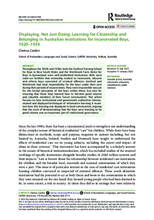Throughout the 1920s and 1930s, both the Gosford Training School for Boys in New South Wales and the Westbrook Farm Home for Boys in Queensland were well-established institutions. Both were state-run facilities that ostensibly existed to incarcerate, educate and reform boys convicted of criminal offences. Gosford and Westbrook had total responsibility for the boys under their care during their periods of incarceration. They were responsible not just for the formal education of the boys within them, but also for ensuring that those boys learned how to become good citizens and valuable members of their future communities.
This article focuses on how institutional and government authorities communicated and displayed techniques of reformative learning. It examines how this learning was displayed to local communities, arguing that the work of demonstrating that the boys were learning to be good citizens was an important part of institutional governance.

